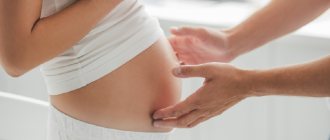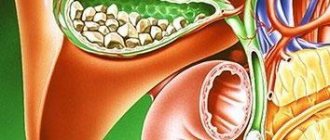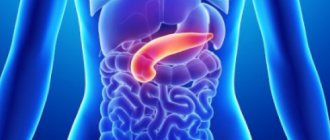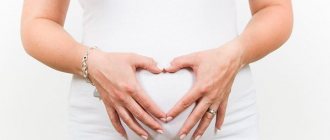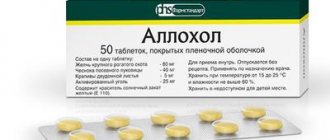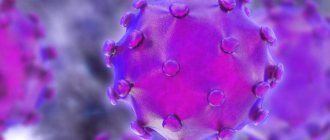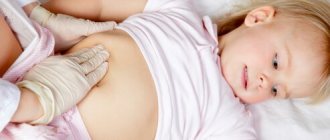Unfortunately, acute cholecystitis during pregnancy is a fairly common occurrence, and this is due to the physiological characteristics of a pregnant woman. The most common cause of the disease is thickening and disruption (slowing or stopping) of the outflow of bile from the gallbladder. At the same time, the hormonal characteristics of a pregnant woman directly contribute to the thickening of bile and a decrease in the force of contraction of the walls of the gallbladder. The fact is that one of the hormones in pregnant women, which ensures the maintenance and progression of pregnancy, is progesterone. It has a relaxing effect on smooth muscles. It plays a very important role in maintaining normal uterine tone during pregnancy. But the effects of progesterone are not limited to the uterine wall; contractile activity of muscle fibers in the wall of the gallbladder is similarly reduced. In some cases, this can lead to complications. It is due to the combination of intestinal displacement (an enlarged uterus displaces surrounding organs), the action of progesterone and thickening of bile that an exacerbation of chronic cholecystitis during pregnancy or the development of primary acute cholecystitis can debut.
Causes of the disease
The development of the disease is facilitated by infections, frequent constipation, a sedentary lifestyle and, of course, eating disorders.
One of the reasons, as well as the most striking manifestation of the disease, is biliary dyskinesia, that is, a violation of their motor activity. There are 2 types of disorders: hypermotor and hypomotor dyskinesia. It is easy to understand that cholecystitis during pregnancy is characterized by the second option. In addition, the course of the disease may be complicated by the presence of gallstones.
Treatment of cholecystitis during pregnancy
If a diagnosis of cholecystitis has been made, then treatment during pregnancy can be of two types:
- Medication
- Surgical
Drug therapy should be prescribed by a qualified doctor, since only he can select the drugs that will help cope with the disease, but at the same time will not harm the developing fetus.
In a situation where the patient’s condition is critical and the problem cannot be solved with medication, the doctor may prescribe an operation to remove part of the gallbladder. This treatment is used only as a last resort.
Main symptoms
One of the manifestations of the disease, most often, is pain in the hypochondrium on the right side. But the nature of the pain will depend on the type of dyskinesia. If there is reduced motor activity, the pain will be aching, dull, with a characteristic feeling of heaviness. If the activity of the biliary tract is increased, the pain will be acute, cramping.
The pain may be accompanied by a bitter taste in the mouth, belching, nausea and vomiting, bloating, and heartburn. It has been noticed that most often the symptoms of cholecystitis intensify after severe dietary violations.
How to treat cholecystitis?
When diagnosed with cholecystitis, treatment in pregnant women largely coincides with that in other groups of sick people. Drug therapy should be prescribed by a doctor, since not all medications can be used to treat this disease. Some of them can negatively affect the fetus.
The standard treatment regimen uses the following types of medications:
- Antispasmodics
- Choleretic
- Drugs that stabilize the gastrointestinal tract and gallbladder
- Antibiotics
- Enzymes
- Prokinetics
- Substances containing lacto- and bifidobacteria
Treatment issues
If you develop cholecystitis during pregnancy, treatment will depend on the stage of the disease. In the initial stages, a therapeutic diet is prescribed taking into account the duration of pregnancy. It is important to understand that while pregnant, restrictions will always be less strict than at any other time. Cholecystitis and pregnancy are a fairly common combination, so diet options have long been developed.
An important addition to the diet will be choleretic agents. These can be either herbal preparations, which can be bought at any pharmacy, or medications.
In cases of acute cholecystitis, hospitalization cannot be avoided. Moreover, in some cases the question of surgical intervention will be raised. However, if there is such an opportunity, they will try to avoid surgery. The woman is prescribed antispasmodics and antibacterial drugs, as well as therapy for biliary dyskinesia.
Cholecystitis during pregnancy: causes, symptoms, diagnosis, treatment
Table of contents
- Why does cholecystitis occur in pregnant women?
- Signs of cholecystitis in pregnant women
- Exacerbation of chronic cholecystitis
- Treatment: cholecystitis during pregnancy
- How to treat cholecystitis
- Advantages of carrying out the procedure at MEDSI
Cholecystitis is an inflammatory disease of the gallbladder with the likelihood of stones (calculi) forming in it. It can be either acute (with a pronounced pain attack) or chronic (with occasional exacerbations). Also, this disease is not always accompanied by the appearance of stones, but if it is not cured in time, their formation is possible as a complication.
Why does cholecystitis occur in pregnant women?
Pregnancy is one of the risk factors for the development of the disease, since during this period a woman’s hormonal levels change significantly, which can become one of the reasons for the formation of cholecystitis.
Factors provoking the appearance of this disease:
- Predisposition to disease
- Infection due to improper functioning of the gastrointestinal tract
- Cholecystitis was chronic and did not cause any inconvenience, but became aggravated during pregnancy
- Previously diagnosed with gallstone disease
- Stagnation of bile due to changes in hormone levels
- Impaired outflow of bile due to changes in the physical position of the gallbladder, its compression and displacement by other organs
According to statistics, pregnant women in the third trimester, as well as middle-aged patients, are most susceptible to the development of cholecystitis.
Signs of cholecystitis in pregnant women
Against the background of the general changed state of the body, it can be quite difficult for a patient who is “in a position” to understand that any serious disease has appeared. To avoid complications and discomfort, you need to pay attention to the following symptoms:
- The appearance of nausea and vomiting, as well as bitterness in the mouth
- Excessive salivation
- Belching or heartburn with a bitter taste
- Pain and discomfort on the right side under the ribs after eating spicy, fried or salty foods
- Excessively long period of toxicosis (in normal condition it lasts up to 12 weeks, and in the presence of cholecystitis - up to 30)
Exacerbation of chronic cholecystitis
The transition of a chronic disease to an acute stage during pregnancy is possible for the following reasons:
- Pressure of the gallbladder by other organs
- The production of certain liver enzymes due to the influence of hormones, which also affects the functioning of the gallbladder
- Distortion of the digestive process
- Bacteria and infection
Treatment: cholecystitis during pregnancy
If a diagnosis of cholecystitis has been made, then treatment during pregnancy can be of two types:
- Medication
- Surgical
Drug therapy should be prescribed by a qualified doctor, since only he can select the drugs that will help cope with the disease, but at the same time will not harm the developing fetus.
In a situation where the patient’s condition is critical and the problem cannot be solved with medication, the doctor may prescribe an operation to remove part of the gallbladder. This treatment is used only as a last resort.
An important part of the treatment of cholecystitis is the diet, within which it is necessary to exclude:
- Drinking alcoholic beverages
- Use of tobacco products
- Fried, salty, spicy, smoked food
- Fatty meat, fish
- Seasonings (spicy)
- Dairy products (fat)
- Legumes
- Coffee
- Chocolate and cocoa-containing products
- Mushrooms
- Carbonated drinks
You should eat 5-6 times a day in small portions:
- Eat fruits and vegetables (not sour)
- Porridge
- Dairy products (low fat)
- Boiled or steamed dishes from dietary meats or fish
- Protein omelettes
- A small amount of vegetable oils
- Unsweetened baked goods (bread, cookies)
- Marmalade, dried fruits
You cannot experience serious physical activity, but you must move: do gymnastics, etc. You should also undergo physiotherapeutic treatment and rehabilitation in a sanatorium under the supervision of specialists.
How to treat cholecystitis
When diagnosed with cholecystitis, treatment in pregnant women largely coincides with that in other groups of sick people. Drug therapy should be prescribed by a doctor, since not all medications can be used to treat this disease. Some of them can negatively affect the fetus.
The standard treatment regimen uses the following types of medications:
- Antispasmodics
- Choleretic
- Drugs that stabilize the gastrointestinal tract and gallbladder
- Antibiotics
- Enzymes
- Prokinetics
- Substances containing lacto- and bifidobacteria
Advantages of carrying out the procedure at MEDSI
- A specialized Women's Health Center has been created in the MEDSI network of clinics, which provides a full range of diagnostic and therapeutic procedures for pregnant patients, including the “Expectant Mother” pregnancy management program
- The Center employs highly qualified doctors of various profiles, so there is no need to travel to several places to undergo a comprehensive examination or treatment
- Specialists monitor innovative developments and constantly improve the level of their own qualifications in large Russian and foreign clinics
- The clinics have new modern expert-level equipment (ultrasound, MRI, etc.) for diagnosing any possible pathologies and abnormalities in fetal development at the initial stage, which allows you to quickly begin treatment and achieve results without harm to the woman and her unborn child
- To make an appointment, you don’t need to stand in line, just call 8 (495) 7-800-500
Drug treatment
Pregnant women should undergo treatment under the supervision of a doctor
When prescribing therapy, the duration of pregnancy is taken into account. During the entire treatment, it is necessary to constantly monitor the condition of the fetus.
When choosing medications, priority is given to choleretic drugs. The most effective remedies are “Hofitol”, “Holebil”, etc. If there is a threat of miscarriage in the first trimester, then medications are prescribed according to strict indications.
Only antispasmodics can relieve severe pain. Drotaverine and papaverine are considered the safest. The use of these drugs is permitted for any period of time. If the pain does not subside, then analgesics are prescribed. It is recommended to drink them for no more than five days.
Safe treatment
Therapy must be prescribed in consultation with the gynecologist who is managing the pregnancy. Treatment is as follows:
| Strict diet | Preference is given to steamed food. |
| Drinking regime | It is necessary to drink mineral water. “Essentuki 17”, “Borjomi”, etc. are perfect. It is advisable to drink a glass of mineral water half an hour before meals. |
| Folk remedies | They will be absolutely safe if you consult your doctor in advance and agree with him what can be consumed and what cannot be consumed. |
| Physiotherapy | An excellent help in the treatment of cholecystitis. Only they can be carried out without exacerbation. |
The main emphasis of therapy is on maintaining a strict diet and drinking regime.
Prognosis and prevention
The prognosis of the disease depends on many factors, for example, the severity of the pathology, the presence of concomitant diseases, the quality of diagnostic measures, and timely treatment. The prognosis is often favorable, but this is subject to compliance with all doctor’s recommendations. The prognosis is worsened by the development of complications that provoke consequences in the form of sepsis and peritonitis.
Disease prevention is of great importance. It should be timely, especially if you are predisposed to diseases of the digestive tract. First of all, a healthy diet, moderate physical activity, and avoidance of alcoholic beverages are recommended. Gastroenterologists insist on an annual medical examination and ultrasound examination of the hepatobiliary system.
Which doctors should I contact?
If symptoms indicate cholecystitis, then consultation with a gastroenterologist is necessary. If there are doubtful manifestations of the disease, you can visit a therapist. The specialist will conduct an examination and collect anamnesis.
It is necessary to carefully examine the oral cavity, especially the tongue. Plaque on the mucous membrane will indicate inflammation of the digestive tract. In addition, palpation will be required. If pain is felt as a result, then the likelihood of cholecystitis is high. However, to make a more accurate diagnosis, hardware diagnostics will be required.
Basic methods for diagnosing inflammation
The persistence of signs of toxicosis or their appearance in late pregnancy is an alarming symptom and you should consult a doctor. To solve the problem, the doctor collects anamnesis, listens to the patient’s complaints, and conducts a physical examination.
Laboratory tests are prescribed - general blood test, urine, biochemistry - liver enzymes are determined.
An effective and safe diagnostic method is ultrasound. It does not have a negative effect on the child, it allows you to identify the disease, the presence of stones, the size, shape and structure of the gallbladder.
Rehabilitation after surgery
After the operation, excessive physical activity and heavy lifting are prohibited. You should adhere to the recommended diet. For a month, you must avoid visiting the sauna, bathhouse, swimming pool, and swimming in open water. In addition, it is important to take the medications prescribed by the doctor upon discharge, since they are needed to restore normal bile secretion.
When the gallbladder is removed, bile from the liver flows into the intestines. At first, it is difficult for the digestive organs to digest fatty foods. However, gradually the tract adapts to work without the organ; the liver will produce less bile. During the rehabilitation period, it is necessary to strengthen the anterior abdominal wall with exercises and limit fat intake.
Prevention
To avoid an unpleasant disease, you should follow some simple rules that will help you stay healthy:
- do special gymnastics every day;
- Take daily walks and breathe fresh air;
- eat right, stick to a diet during an exacerbation and during remission.
Compliance with these rules guarantees your health.
Watch a video with gymnastics for the gallbladder:
Pathogenesis
Previously, treatment of cholecystitis in men and women was aimed at eliminating bacterial flora, since it was believed that the main factor in the development of pathology was associated with pathogenic microflora. To date, opinions regarding the pathogenesis have changed, which is why the treatment regimen has changed.
First of all, the development of the acute form of the disease is associated with a block of the gallbladder, which subsequently triggers all pathological processes in the organ. The blockage occurs when the cystic duct is blocked by a stone. As a result, the outflow of bile is disrupted, and intravesical pressure increases. The condition is aggravated by swelling and reflex spasm.
The microflora located in the bile ducts is activated, provoking an inflammatory process. The severity of hypertension directly depends on the degree of pathological changes in the tissues of the organ.
The danger of high pressure in the biliary tract also lies in the fact that it triggers many diseases of the digestive tract, namely the hepatoduodenal region. As the inflammatory process progresses, it spreads to the mucous membrane and muscle layer, and this leads to a significant decrease in contractile function, and sometimes paresis occurs.
Traditional methods
Traditional medicine has always been popular. But before resorting to it, you need to consult a doctor. Help with cholecystitis:
| Dandelion roots | Boil for five minutes. Allow the broth to cool slightly, at the same time it will infuse and acquire healing properties. After this, the infusion should be filtered. Take only half a glass warm before meals. |
| Corn silk | Dry and fill with boiled, slightly cooled water in a 1:1 ratio. Infuse during the day. Take the warm infusion three times a day. |
| Beet juice | You need to use the juice of undercooked beets. Drink one tablespoon half an hour before meals. |
These folk remedies have a choleretic effect and are natural antispasmodics.
Nutrition and diet
Nutrition should be balanced
The issue of nutrition is fundamental in the treatment of cholecystitis. Following a diet helps eliminate bile stagnation and also helps relieve the inflammatory process. Meals should be frequent, but small (4-5 times a day).
Under no circumstances should you overeat or starve. Fried, fatty, spicy, canned and smoked foods are prohibited. It is not recommended to eat vegetables that contain essential oils, chocolate, coffee, and mushrooms.
Boiled fish, lean meat, vegetables, and fruits will be beneficial. Fermented milk products will also be very useful: yogurt, low-fat kefir, fermented baked milk, sour cream, etc. It is recommended to start the morning with porridge, and for lunch be sure to eat vegetable soups and broths.
Complications and consequences for the fetus
Any disease, if left untreated, has its complications and consequences. And cholecystitis is no exception. It can cause pylephlebitis and peritonitis.
Severe pain can trigger premature labor. In 20% of cases there is a real threat of miscarriage. Possible intrauterine growth retardation.
Also, the woman’s metabolism is disrupted, a feeling of weakness, loss of strength, and apathetic mood appear. Immunity decreases, which contributes to the exacerbation of infectious diseases.
Classification
Gastroenterologists attach great importance to the classification of pathology, since this allows specialists to select the most appropriate treatment tactics for cholecystitis. Based on the severity of symptoms and the degree of the inflammatory process, acute and chronic forms of the disease are distinguished.
| View | Peculiarities |
| Acute cholecystitis | Characterized by severe symptoms and manifestations of intoxication. Patients report severe wave-like pain. It is worth noting that attacks of acute cholecystitis often occur in women during pregnancy, which is associated with a sharp change in hormonal levels, especially in the third trimester. With early treatment for cholecystitis, the prognosis is positive, but repeated attacks indicate that the disease has become chronic. |
| Chronic cholecystitis | It is characterized by a slow course without pronounced symptoms. The pain is mild and may be completely absent. |
According to the nature of the flow, they are distinguished:
- recurrent (alternating periods of exacerbation and remission);
- monotonous (no relapses, constant discomfort and pain);
- intermittent (against the background of mild manifestations, colic and intoxication phenomena are noted).
In addition, a distinction is made between calculous and non-calculous, that is, acalculous cholecystitis. In the presence of stones (this is more than 90% of cases), the manifestations of the disease are pronounced, sometimes accompanied by attacks of colic.
Acalculous cholecystitis is characterized by the absence of stones and rare exacerbations. As a rule, this form is associated with dietary errors.
